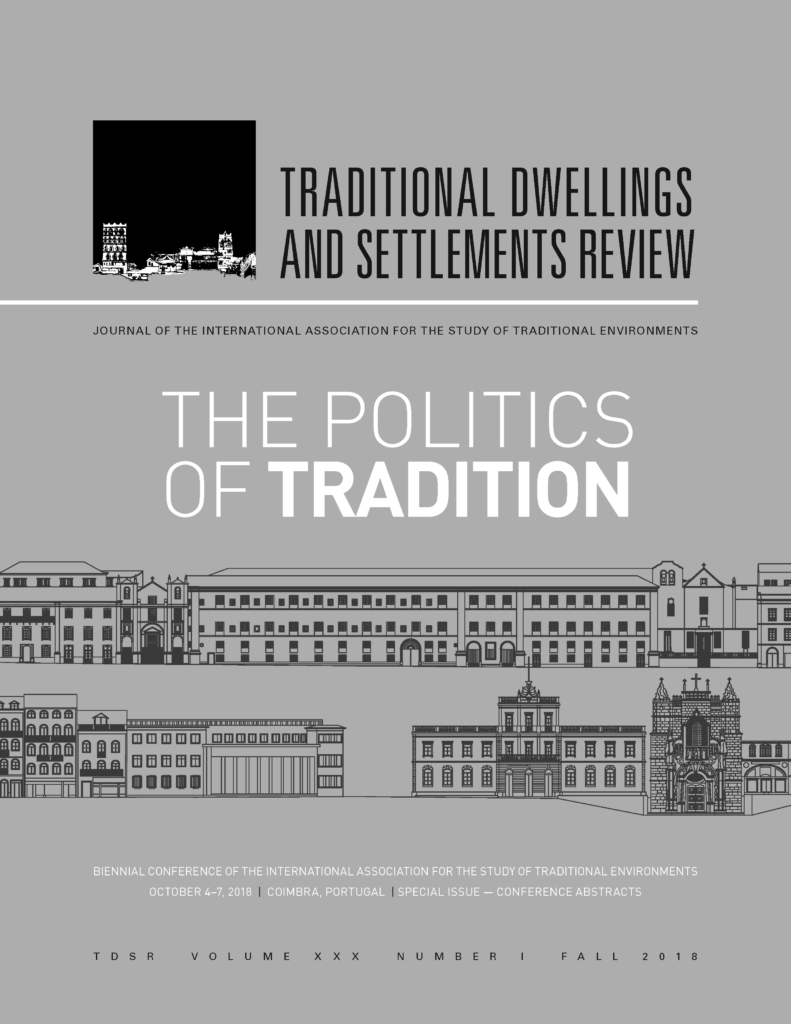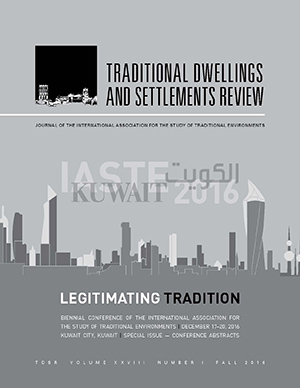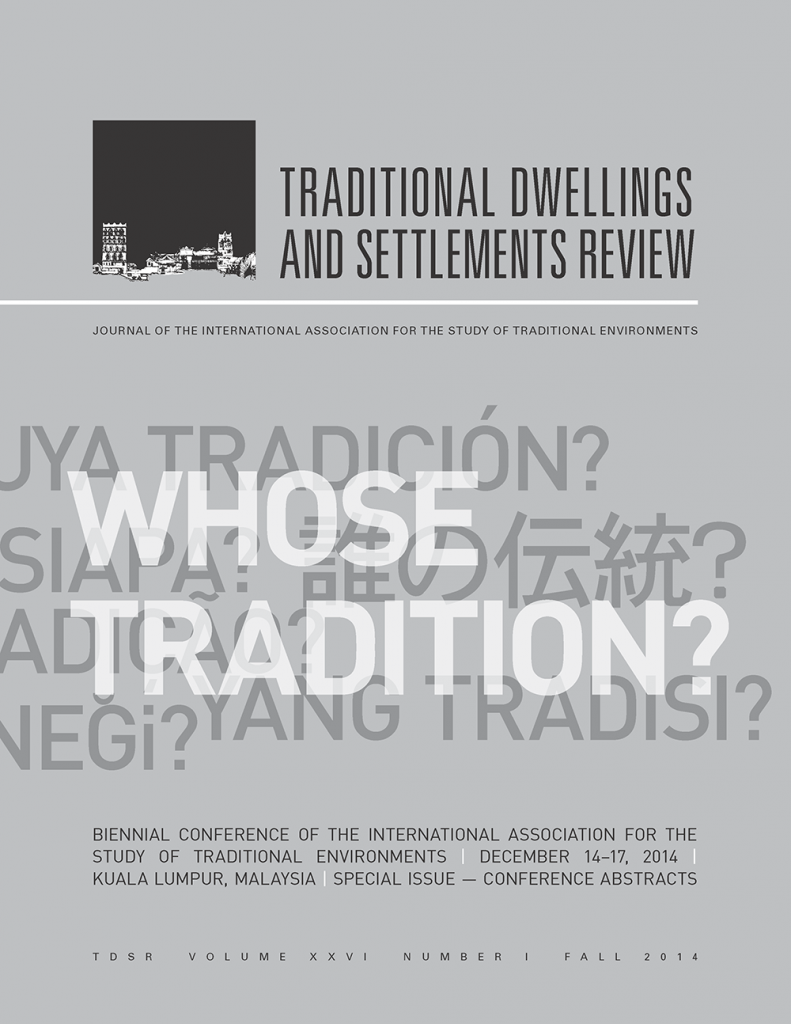
SCOPE I PEOPLE I EDITORIAL POLICIES I PUBLICATION ETHICS I MANUSCRIPTS GUIDE I TDSR VOLUMES I SUBMIT TO TDSR
Fall 2023 Volume 35.1
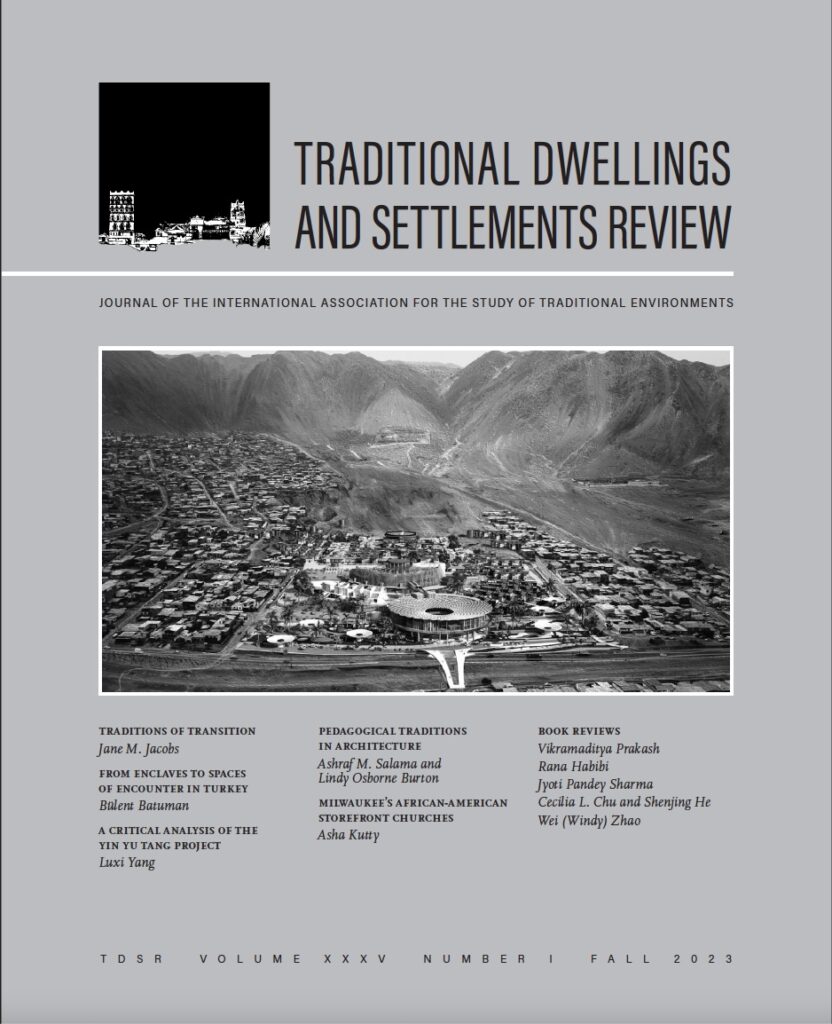
Editor’s note
Feature articles
Traditions of Transition: Towards a Fully Terrestrial Built Environment
Jane M. Jacobs
From Enclaves to Spaces of Encounter: Post-Gezi Urban Politics of Islamic Minorities in Turkey
Bülent Batuman
A Critical Analysis of the Yin Yu Tang Project: Examining Its Evolving Identities in China
Luxi Yang
on pedagogy: Pedagogical Traditions in Architecture: The Canonical, the Resistant, and the Decolonized
Ashraf M. Salama and Lindy Osborne Burton
field report
73 Milwaukee’s African-American Storefront Churches: “Makeshifting” and Spatial Resilience in Urban America
Asha Kutty
Book Reviews
One Continuous Line: Art, Architecture and Urbanism of Aditya Prakash, by Vikramaditya Prakash
Reviewed by manu p. sobti
Modern Middle-Class Housing in Tehran, Reproductions of an Archetype: Episodes of Urbanism, 1945–1979, by Rana Habibi
Reviewed by somaiyeh falahat
Colonialism, Uprising and the Urban Transformation of Nineteenth-Century Delhi, by Jyoti Pandey Sharma
Reviewed by amita sinha
Speculative City: Emergent Forms and Norms of the Built Environment, edited by Cecilia L. Chu and Shenjing He
Reviewed by jayde lin roberts
Home Beyond the House: Transformation of Life, Place, and Tradition in Rural China, by Wei (Windy) Zhao
Reviewed by huaqing huang
Spring 2023 Volume 34.2
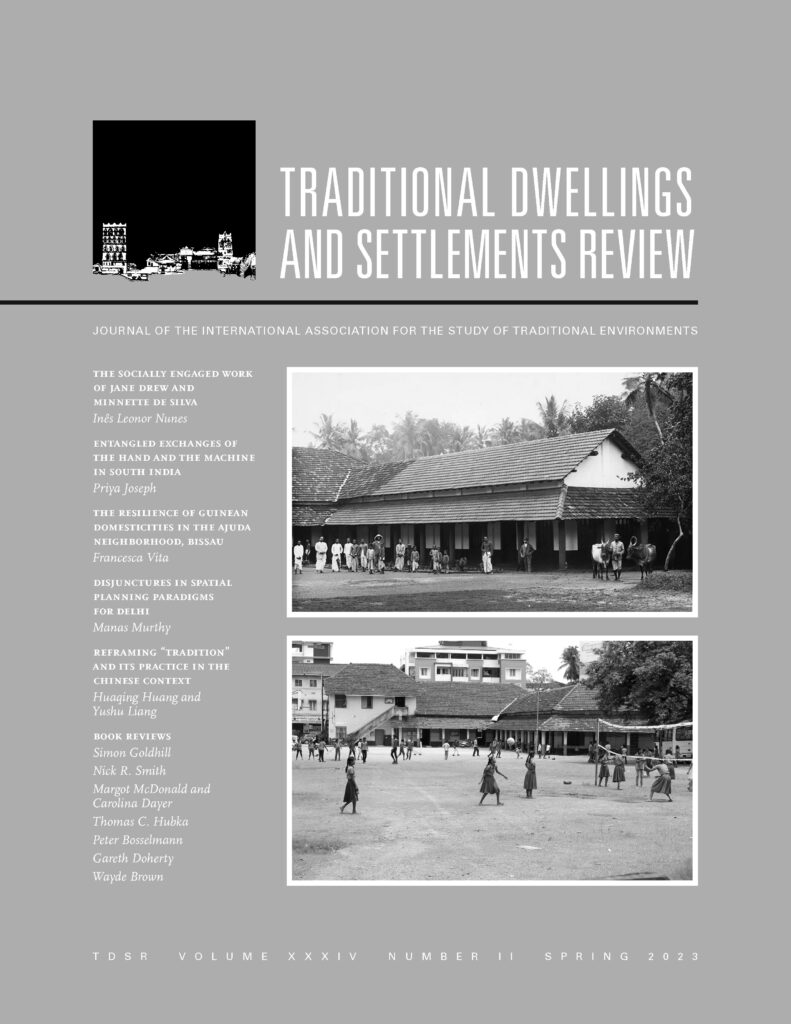
Contents
Editor’s note
Feature articles
Women Architects Disrupting Tropical Modernism: The Socially Engaged Work ofJane Drew and Minnette De Silva
Inês Leonor Nunes
Rupturing Terracotta: Entangled Exchanges of the Hand and the Machine in South India
Priya Joseph
The Entanglement between Traditions and Colonial Spatiality: The Resilience ofGuinean Domesticities in the Ajuda Neighborhood, Bissau
Francesca Vita
Breaking and Making Traditions: Disjunctures in Spatial Planning Paradigms for Delhi
Manas Murthy
Special report on the roundtable at iaste 2022 Reframing “Tradition” and Its Practice in the Chinese Context: The Chinese Edition of Nezar AlSayyad’s Traditions: The “Real,” the Hyper, and the Virtual in the Built Environment
Huaqing Huang and Yushu Liang
Book reviews
Being Urban: Community, Conflict and Belonging in the Middle East, edited by Simon Goldhill reviewed by Bülent batuman
The End of the Village: Planning the Urbanization of Rural China, by Nick R. Smithreviewed by Tim Heath
Activism in Architecture: Bright Dreams of Passive Energy Design, edited by Margot McDonald and Carolina Dayer reviewed by Fred Tepfer
How the Working-Class Home Became Modern, 1900–1940, by Thomas C. Hubkareviewed by Howard Davis
Adaptations of the Metropolitan Landscape in Delta Regions, by Peter Bosselmannreviewed by Lyndsey Deaton
Paradoxes of Green: Landscapes of a City-State, by Gareth Doherty reviewed by Amir Gohar
Reconstructing Historic Landmarks: Fabrication, Negotiation and the Past, by Wayde Brown reviewed by Hossam Mahdy
IASTE 2024 Conference, January 5– 9, Ryadh, Saudi Arabia
Fall 2022 Volume 34.1
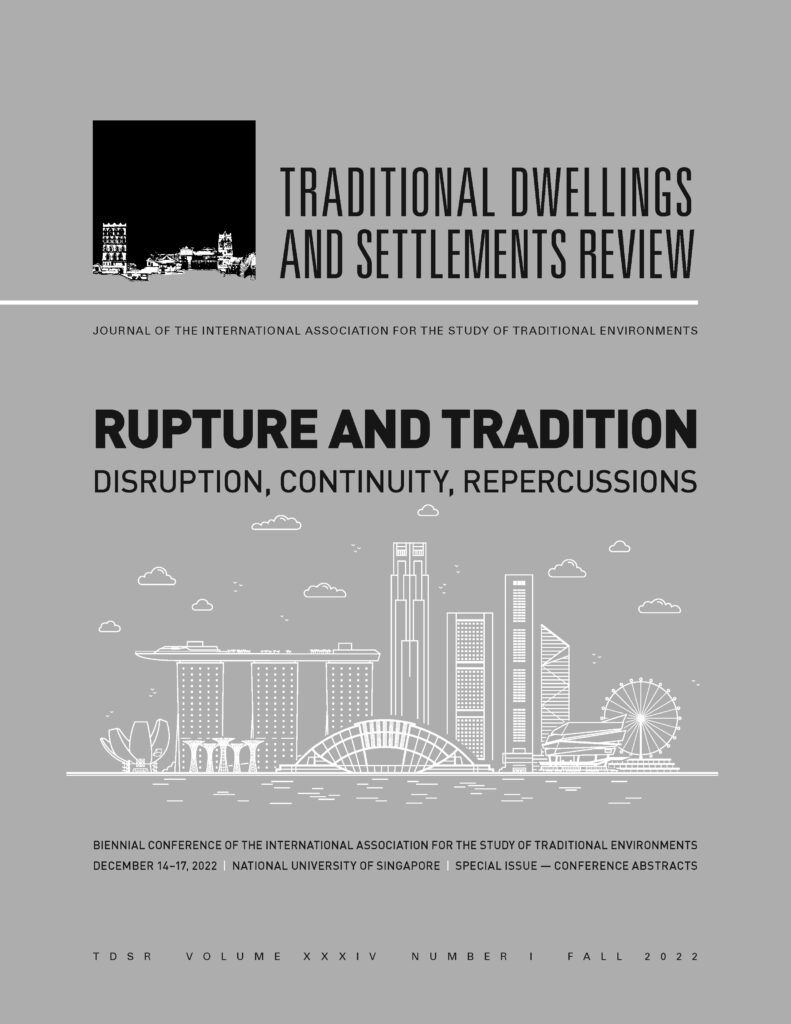
Editor’s Note
This special issue of Traditional Dwellings and Settlements Review is dedicated iaste’s 2022 Conference, to be held in December in Singapore under the theme of “Rupture and Tradition”. As with past special TDSR conference issues, it intends to provide individual and institutional iaste members who are unable to attend with informa-tion about the content of the event. For those attending, the issue serves the addi-tional purpose of providing a preliminary document for discussion, as it contains all abstracts of papers accepted for presentation.
Past iaste conferences have dealt with themes as diverse as authenticity, value, myth, utopia, politics, and virtual traditions. The theme of the Seventeenth iaste Conference is designed to provide a collective reflection by foregrounding an examina-tion of the ways traditions in the built environment are changing in the current era of globalization. The COVID-19 pandemic years have certainly provided such a moment, which may be used to reflect on the ways that “rupture,” in its multifarious forms, has shaped traditional environments.
Paper in the conference explore how the “ruptures” caused by the ongoing pandemic are restructuring the ways traditions operate and are understood. To de-scribe a rupture is to describe an event that makes the difference between a before and an after. A rupture is a crack, assure, an impassable chasm, or a wrinkle in time. Whether understood in a temporal, physical, or topographic sense, ruptures have played an important part in the making of buildings and cultural landscapes. Instead of simply considering direct responses to this global crisis, our conference on “Rupture and Tradition” is also interested in the slower, more long-term processes by which traditions consolidate history-altering events. Indeed, it is often through re-percussions felt elsewhere, rather than the event itself, that ruptures produce change, altering traditions and their forms of continuation.
This year conference brings together more than 120 scholars and practitioners from a variety of disciplines including architecture, architectural history, art history, anthropology, archaeology, conservation, folklore, geography, history, planning, and urban studies. Their papers are structured around three broad themes: disruption, continuity, and repercussions.
For those attending the conference, we hope this document will help you select among the sessions and papers you would like to attend, and for those who are unable to be with us in Singapore we hope this special issue of the journal will give you a good sense of the content of the conference.
Spring 2022 Volume 33.2
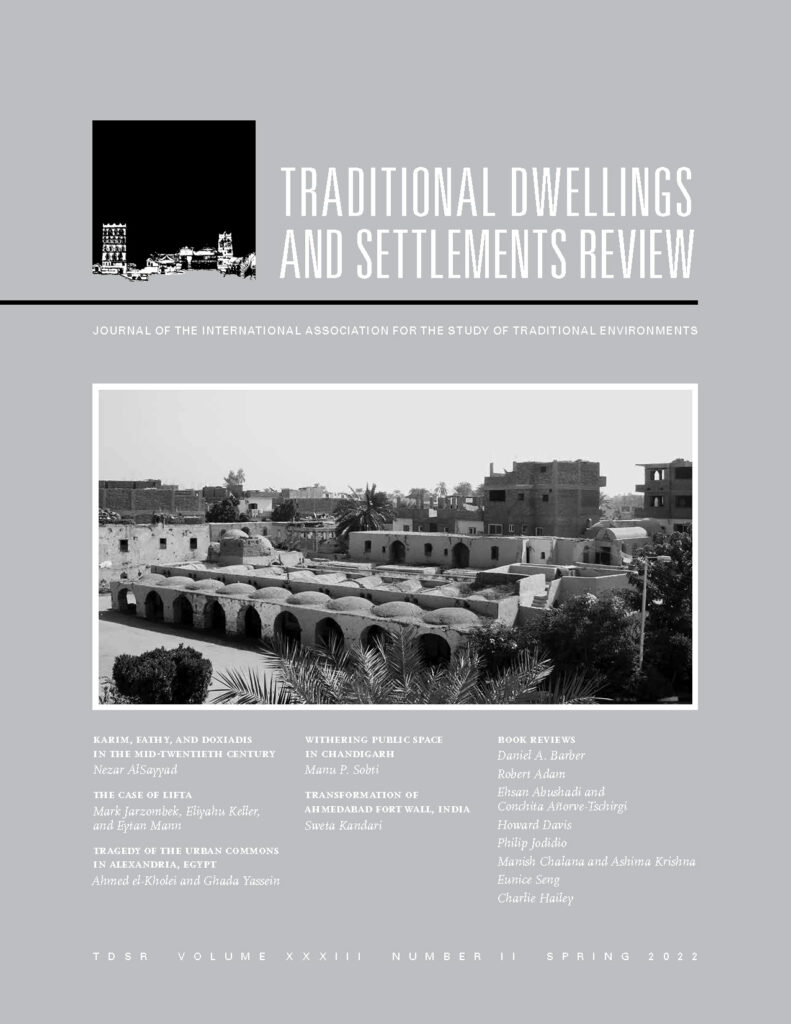
Contents
Editor’s note
Feature articles
Encounters of Modernity and Tradition in Nasser’s Egypt: Architecture and Planning
Discourses of Karim, Fathy and Doxiadis in the Mid-Twentieth Century
Nezar AlSayyad
Site, Archive, Medium and the Case of Lifta
Mark Jarzombek, Eliyahu Keller, and Eytan Mann
When Public Spaces Speak: Investigating the Tragedy of the Urban Commons inAlexandria, Egypt
Ahmed el-Kholei and Ghada Yassein
Withering Public Space in Chandigarh: Transforming Retail and SocialChoreographies in the Neoliberal Indian Mall
Manu P. Sobti
Field report
59 Continuity, Change and Adaptation: Understanding the Transformations ofAhmedabad Fort Wall, India
Sweta Kandari
Book reviews
Modern Architecture and Climate: Design before Air Conditioning, by Daniel A. Barber reviewed by daniel j. ryan
Time for Architecture, by Robert Adam reviewed by laurence keith loftin
The Architecture of Ramses Wissa Wassef, by Ehsan Abushadi and Conchita Añorve-Tschirgi reviewed by dina taha
Working Cities: Architecture, Place and Production, by Howard Davis reviewed by sharóne l. tomer
Lahore: A Framework for Urban Conservation, edited by Philip Jodidio reviewed by hossam mahdy
Heritage Conservation in Postcolonial India: Approaches and Challenges, edited by Manish Chalana and Ashima Krishna reviewed by saumya sharma
Resistant City: Histories, Maps, and the Architecture of Development, by Eunice Seng reviewed by nihal perera
The Porch: Meditations on the Edge of Nature, by Charlie Hailey reviewed by bob mugerauer
IASTE 2022 conference, december 14–1 7, singapore
Fall 2021 Volume 33.1

Special Issue : VIRTUAL TRADITIONS
EDITOR’S NOTE
KEYNOTE PRESENTATIONS
IMMERSING IN THE PAST, MEDIATING THE PRESENT: ONTOLOGICAL FRAMING OF DIGITAL SPACE IN TRADITIONAL ENVIRONMENTS, Puay-Peng Ho
SEEING TRADITION AFRESH: THE ANCIENT WORLD IN VIRTUAL REALITY, Michael Scott
TRACK I: THEORIZING THE VIRTUAL AND THE TRADITIONAL IN THE BUILT ENVIRONMENT
A.1 VIRTUAL RECONSTRUCTIONS
A.2 THE VIRTUAL VS. THE REAL
A.3 DIGITAL TOOLS
A.4 DIGITIZING IN THEORY AND PRACTICE
A.5 MANAGING GLOBALIZATION AND TRADITION
A.6 MUSEUMS, MEMORIALS, AND TRAVEL
A.7 IMPACTS OF A DIGITAL AGE
A.8 SPACE, SOCIAL MEDIA, AND DIGITAL APPS
TRACK II: THE SOCIO-SPATIAL TRADITIONS OF EVERYDAY LIFE IN CHANGING LANDSCAPES
B.1 TRADITIONAL BUILDINGS AND SETTLEMENTS
B.2 TRADITION VS. MODERNITY: TRANSFORMING PLACES
B.3 INDIGENOUS AND CULTURAL LANDSCAPES
B.4 INDIGENOUS AND VERNACULAR DISCOURSES
B.5 VERNACULARS, NEW AND OLD: TRANSFORMING TYPOLOGIES
B.6 IDENTITY, ETHNICITY, AND ARCHITECTURE
B.7 PEOPLE, PLACE, AND TRADITION
B.8 DESIGN, EDUCATION, AND DEVELOPMENT
TRACK III: TRADITION, SPACE, AND PROFESSIONAL PRACTICE IN THE BUILT ENVIRONMENT AT TIMES OF TRANSITION
C.1 THE PRACTICE OF DESIGN
C.2 PLANNING AND PLACEMAKING
C.3 INFORMAL URBANISM AND REFUGEE RESETTLEMENT
C.4 ART, CRAFT, AND ARCHITECTURE
C.5 MIGRANT COMMUNITIES AND URBANIZATION
C.6 TRIGGERING SOCIOSPATIAL TRADITIONS
C.7 SEGREGATION AND SOCIAL SPACE
C.8 OPEN SESSION: ART, CRAFT, AND ARCHITECTURE
Spring 2021 Volume 32.2

EDITOR’S NOTE
FEATURE ARTICLES
– Heritage Management: Global Aspirations and Local Realities in Thailand, Montira Horayangura Unakul
–Literary History and Architectural Traditionalism in Portugal and Brazil, Pedro P. Palazzo
–Architecture, Heritage and the Metaverse: New Approaches and Methods for the Digital Built Environment, Andrea Moneta
–Virtual Velocities: Urban and Ecological Trajectories in Planning for a New Indonesian Capital, Diane Valerie Wildsmith
FIELD REPORT
Shimla: A Case Study of Transition from a Colonial Capital to an Indian Town, Saumya Sharma
Fall 2020 Volume 32.1

EDITOR’S NOTE
FEATURE ARTICLES
–Digitizing Heritage as an Integrated, Sustainable Tool for Interpretation of the Past: The Case of Umm Qais, Jordan
Gehan Selim, Monther Jamhawi, Andrew Holland, and Shouib Ma’bdeh
–When Boston Isn’t Boston: Useful Lies of Reconstructive Game Models,Aurélien Catros and Maxime Leblanc
–Indigenous Placemaking in the Climate Diaspora: Rimajol Resettlement in the U.S., James Miller
–Whose Habitat? Housing and the Dilemma of Architectural Production, c.1976,Eunice Seng
Spring 2020 Volume 31.2
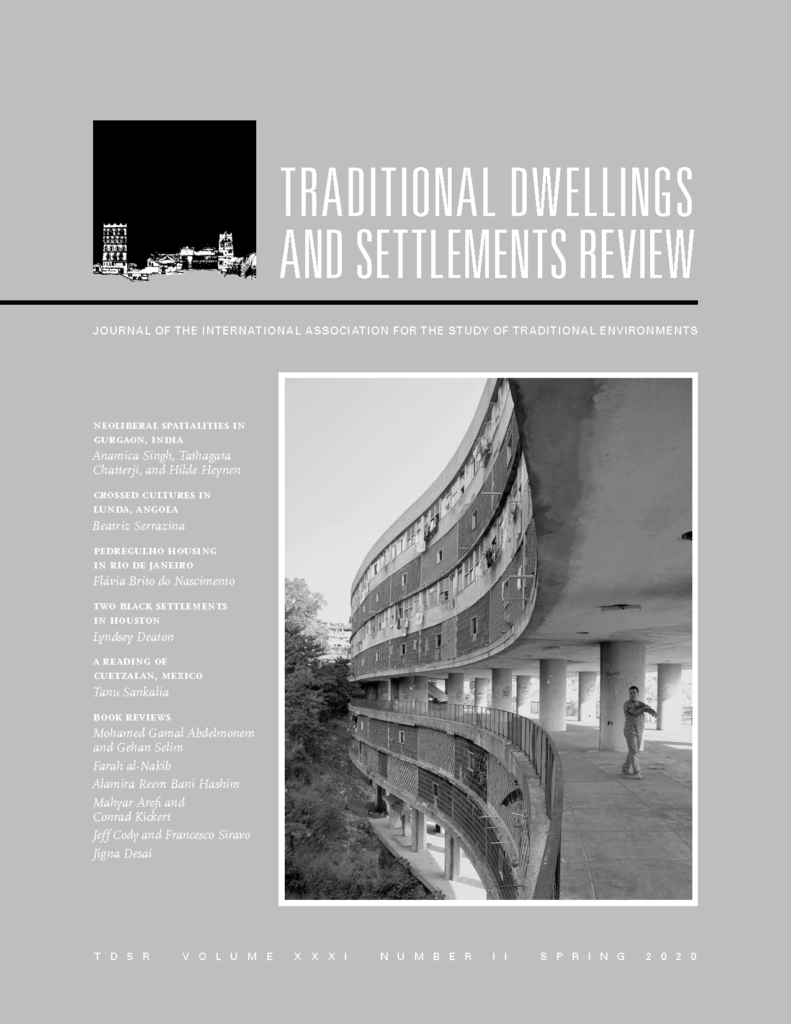
Contents
EDITOR’S NOTE
FEATURE ARTICLES
Neoliberal Spatialities in Gurgaon: Privatization, Negotiation and Reciprocity in India
Anamica Singh, Tathagata Chatterji, and Hilde Heynen
Crossed Cultures in Lunda, Angola: Diamang’s Urban Project and Its Legacies
Beatriz Serrazina
Modern Again: Tradition and Modernity in the Pedregulho Housing Complex in Rio de Janeiro
Flávia Brito do Nascimento
Freedmen’s Town Versus Frenchtown: A History of Two Black Settlements in Houston, Texas
Lyndsey Deaton
FIELD REPORT
Hybrid Place: A Reading of Cuetzalan, Mexico
Tanu Sankalia
Fall 2019 Volume 31.1
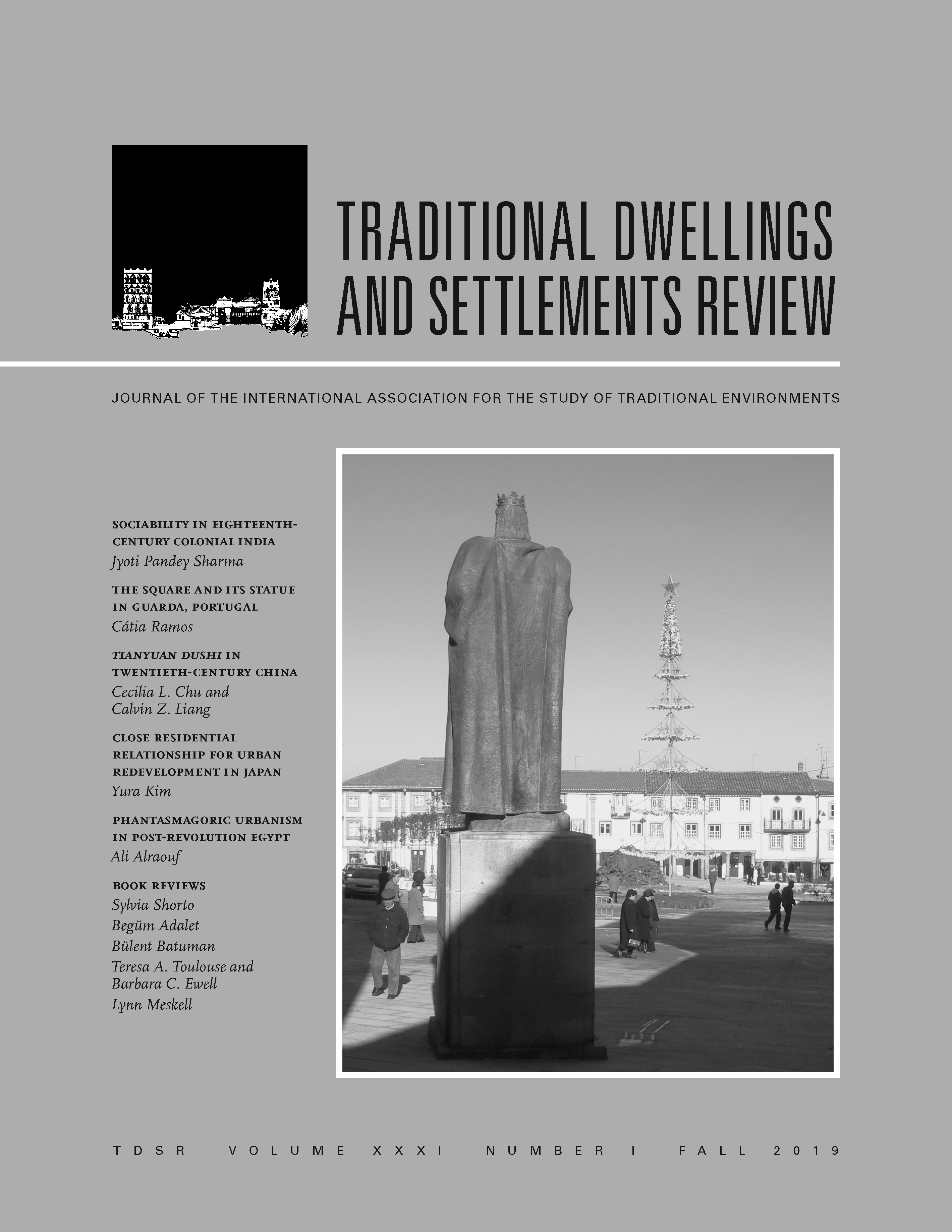
Contents
EDITOR’S NOTE
FEATURE ARTICLES
Sociability in Eighteenth-Century Colonial India: The Nabob, Nabobian Kothi, and the Pursuit of Leisure
Jyoti Pandey Sharma
The Square and Its Statue: How a Dictatorship Shaped Tradition and How Architecture Reshaped It in Guarda, Portugal
Cátia Ramos
Tianyuan Dushi: The Garden City, Urban Planning, and Visions of Modernization in Early-Twentieth-Century China
Cecilia Chu and Calvin Z. Liang
FIELD REPORT
The Effectiveness of the Close Residential Relationship for Urban Redevelopment in Japan
Yura Kim
COMMENTARY
Phantasmagoric Urbanism: Exploiting the Culture of Image in Post-Revolution Egypt
Ali Alraouf
Spring 2019 Volume 30.2
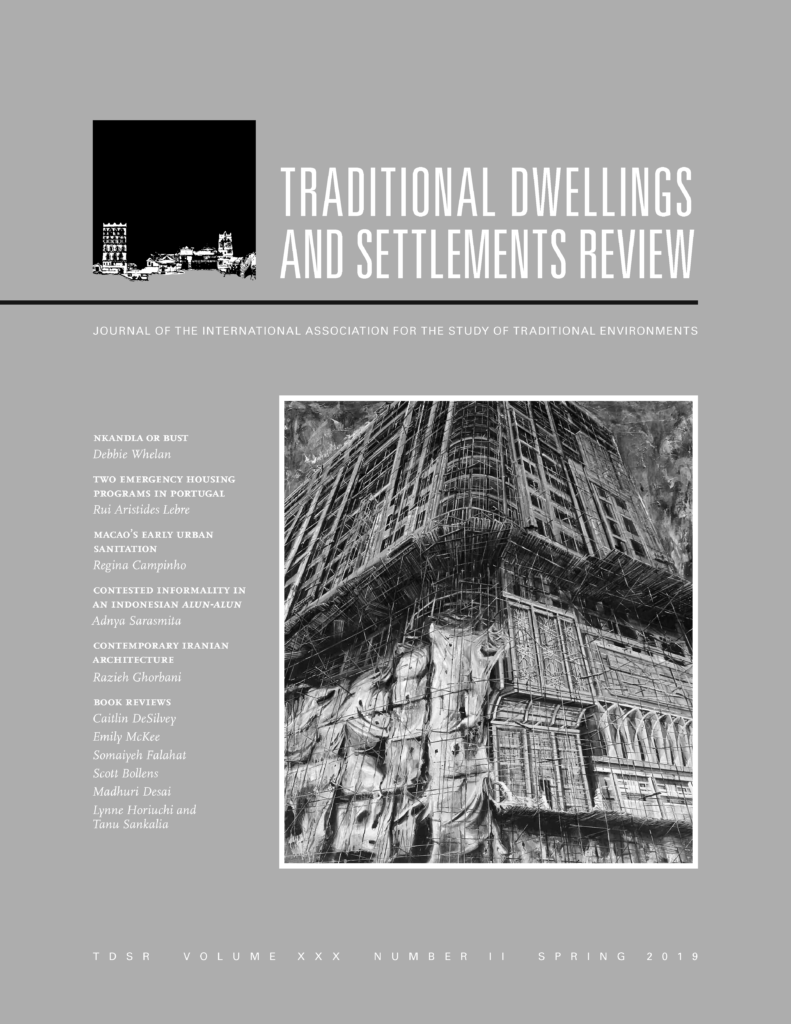
Contents
Editor’s note
Nkandla or Bust: Neo-Traditions, Politics, and the Fire-Pool
Debbie Whelan
Homeownership, Design, and Postcolonial Citizenship: Comparing Two Emergency Housing Programs in Portugal, 1974–82
Rui Aristides Lebre
Hoping for Catastrophe: Epidemic Threat and Political Ambition in Colonial Macao’s Early Attempts at Urban Sanitation, 1885–1900
Regina Campinho
(Co)Production of Urban Public Space: Contested Informality in an Indonesian Alun-Alun
Adnya Sarasmita
Field report: Resurrecting Tradition, Rewriting Modernity: Experiments in Contemporary Iranian Architecture under Economic Recession,
Razieh Ghorbani
Book Review
IASTE 2020, Call for abstracts: “Virtual Traditions”
Fall 2018 Volume 30.1
Spring 2018 Volume 29.2
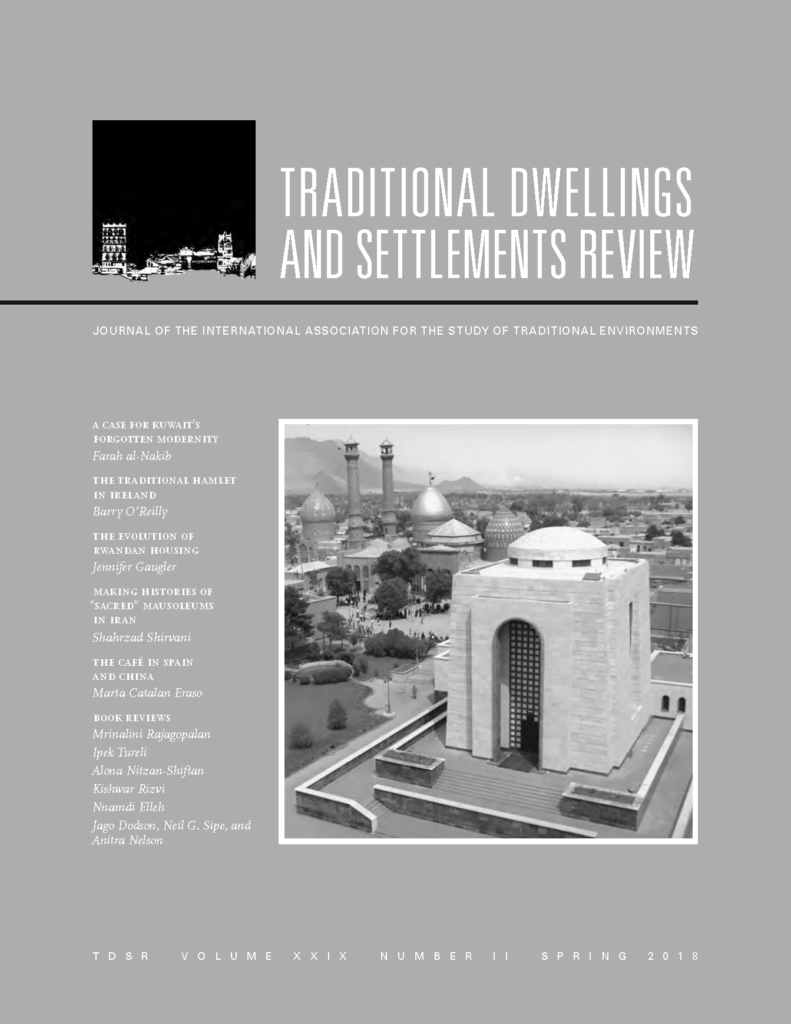
Contents
Editor’s note
Legitimizing the Illegitimate: A Case for Kuwait’s Forgotten Modernity,
Farah al-Nakib
“A Shower from the Sky”: Legitimating the Traditional Hamlet in Ireland,
Barry O’Reilly
Modern Materials for Dwelling: The Evolution of Durability and Domesticity in Rwandan Housing,
Jennifer Gaugler
Making Histories of “Sacred” Mausoleums: Architectural Representation of Changing Islamic Ideologies,
Shahrzad Shirvani
Field Report: Globalizing Tradition: The Changing Careers of the Café in Spain and China, Marta Catalan Eraso
Fall 2017 Volume 29.1
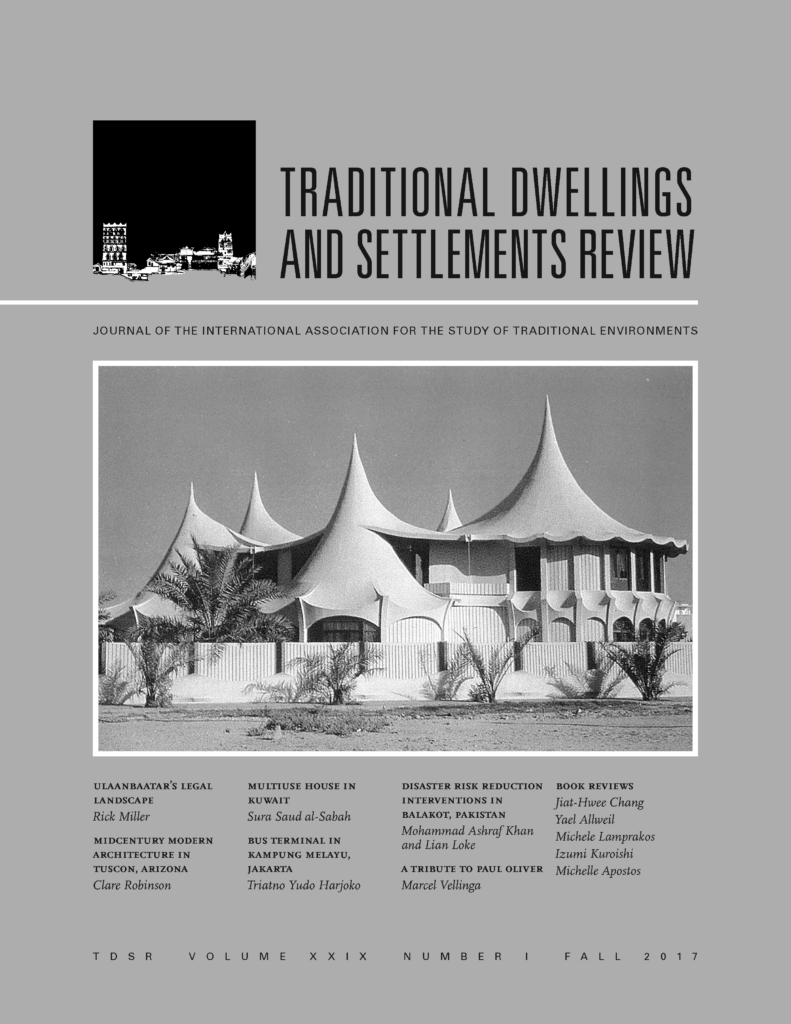
Settling between Legitimacy and the Law: At the Edge of Ulaanbaatar’s Legal Landscape
Rick Miller
Unrepressing Class to Reinterpret the Tradition of Midcentury Modern Architecture in Tuscon, Arizona
Clare Robinson
A Future Vision for the Multiuse House in Kuwait: Between acceptance and Rejection
Sura Saud al-Sabah
I Dwell in [Im]possibility: Legitmating the Informal Economy around the Bus Terminal in Kampung Melayu, Jakarta
Triatno Yudo Harjoko
Field Report
A Nexus of Social Justice, Tradition, and Disaster Risk Reduction in Balakot, Pakistan: Fostering Independence or Dependence?
Mohammad Ashraf Khan and Lian Loke
Special Report
A Tribute to Paul Oliver
Marcel Vellinga
Spring 2017 Volume 28.2
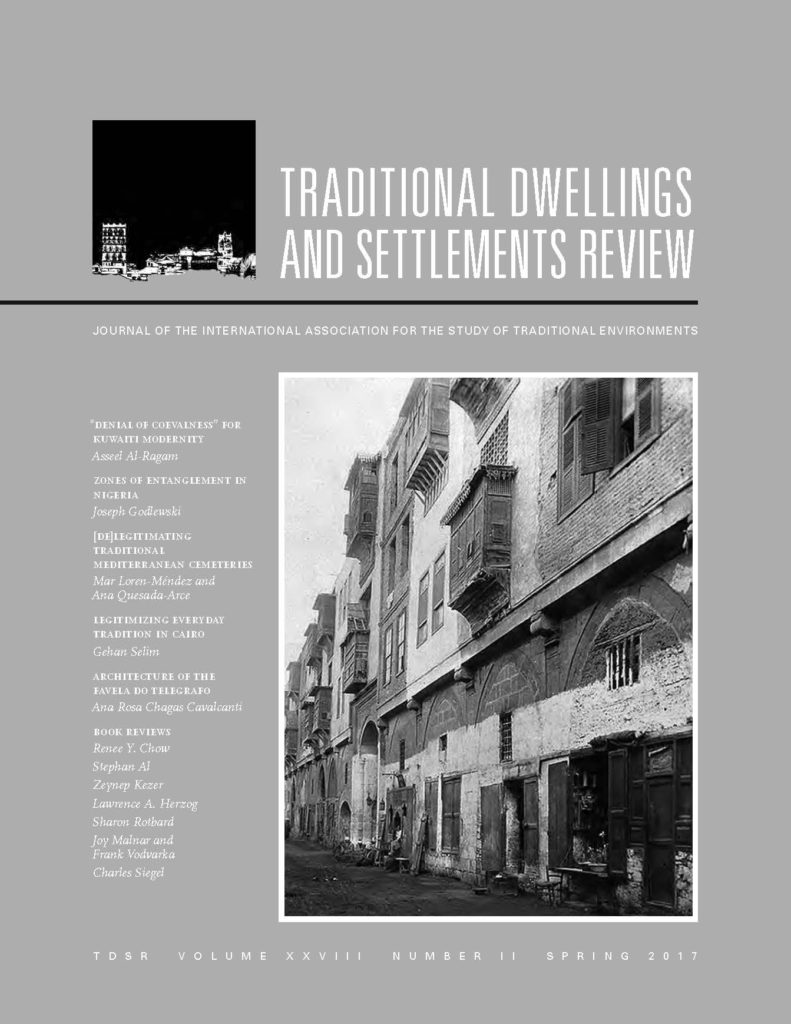
Contents
Editor’s Note
“Denial of Coevalness”: Discursive Practices in the Representation of Kuwaiti Urban Modernity
Asseel Al-Ragam
Zones of Entanglement: Nigeria’s Real and Imagined Compounds
Joseph Godlewski
[In]Visibility of Death in the Built Environment: [De]Legitimating Traditional Mediterranean Cemeteries in Southern Spain
Mar Loren-Méndez and Ama Quesada-Arce
Legitimizing Everyday Tradition: The Spatial Narrative of Modernity in Cairene Old Quarters
Gehan Selim
Work, Slums, and Informal Settlement Traditions: Architecture of the Favela Do Telegrafo [Field Report]
Ana Rosa Chagas Cavalcanti
Book Reviews
Fall 2016 Volume 28.1
Spring 2016 Volume 27.2
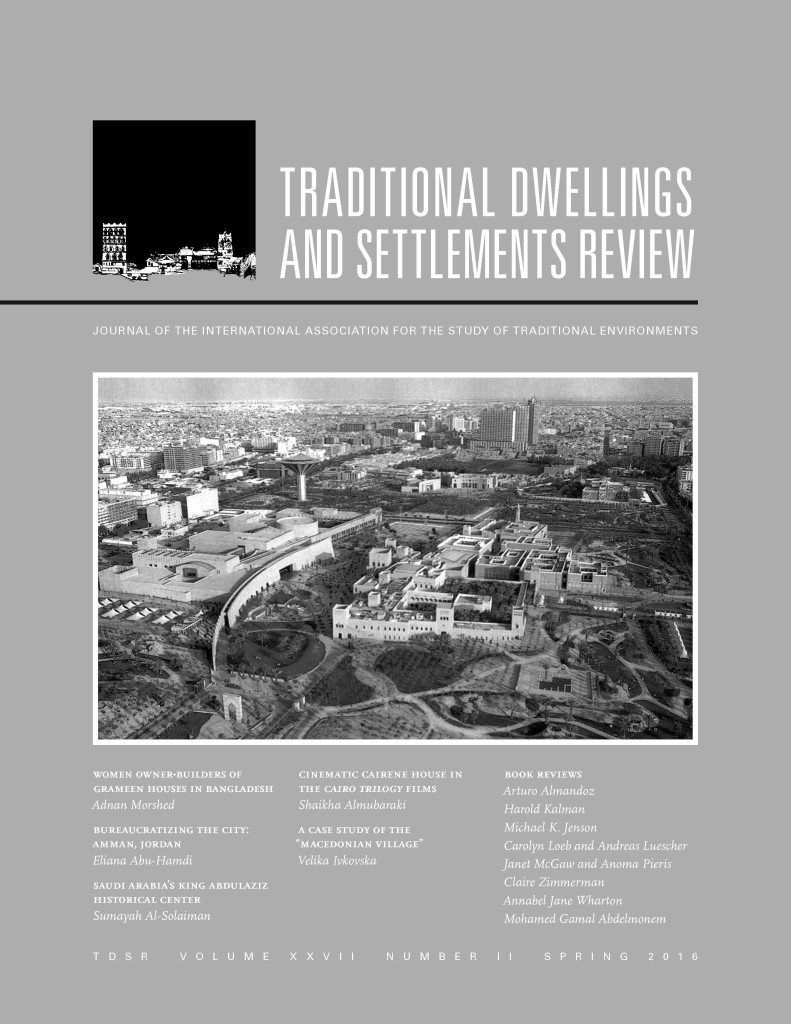
The Politics of Self-Help: Women Owner-Builders of Grameen Houses in Rural Bangladesh
Adnan Morshed
Bureaucratizing the City: Moderated Tribalism, Regime Security, and Urban Transformation in Amman, Jordan
Eliana Abu-Hamdi
Architecture as a Tool of Editing History: The Case of Saudi Arabia’s King Abdulaziz Historical Center
Sumayah Al-Solaiman
The Cinematic Cairene House in the Cairo Trilogy Films
Shaikha Almubaraki
Reinventing Vernacular Traditions to Reveal National Identity: A Case Study of the “Macedonian Village” [Field Report]
Velika Ivkovska
Fall 2015 Volume 27.1
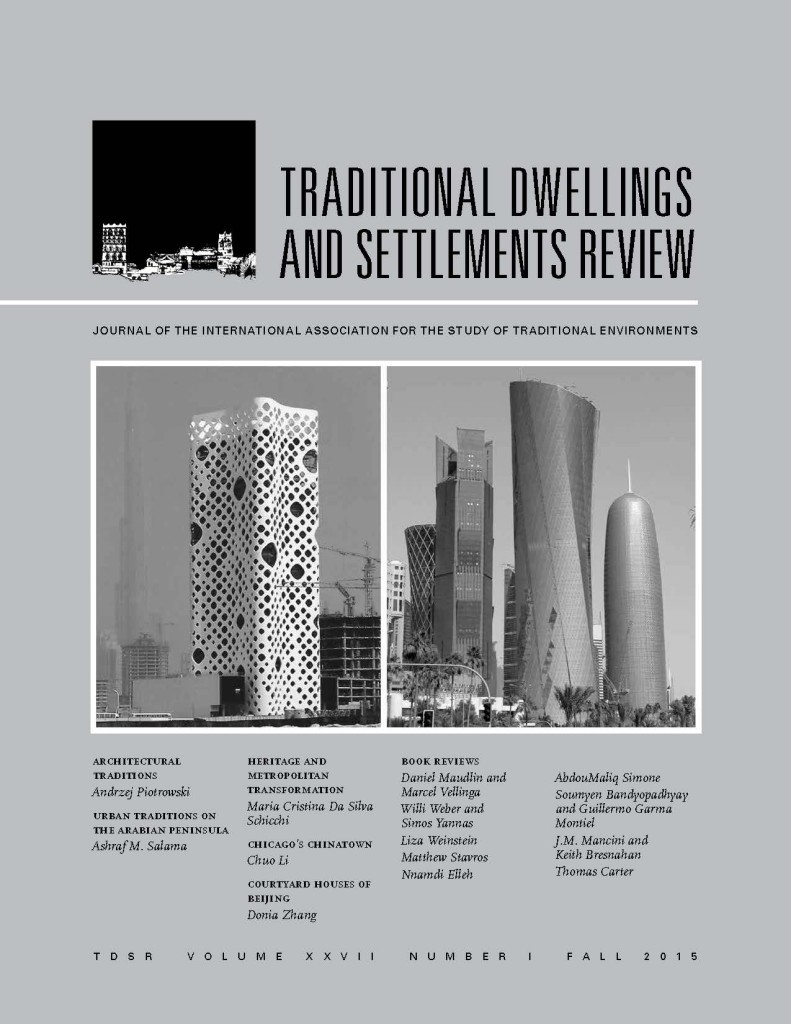
Contents
Editor’s Note
Heresy, Hybrid Buildings, and a Geography of Architectural Traditions
Andrzej Piotrowski
Urban Traditions in the Contemporary Lived Space of Cities on the Arabian PeninsulaAshraf M. Salama
The Cultural Heritage of Small and Medium-Size Cities: A New Approach to Metropolitan Transformation in São Paulo, Brazil
Maria Cristina Da Silva Schicchi
Interrogating Ethnic Identity: Space and Community Building in Chicago’s Chinatown
Chuo Li
Courtyard Houses of Beijing: Lessons from the Renewal [Field Report]
Donia Zhang
Spring 2015 Volume 26.2
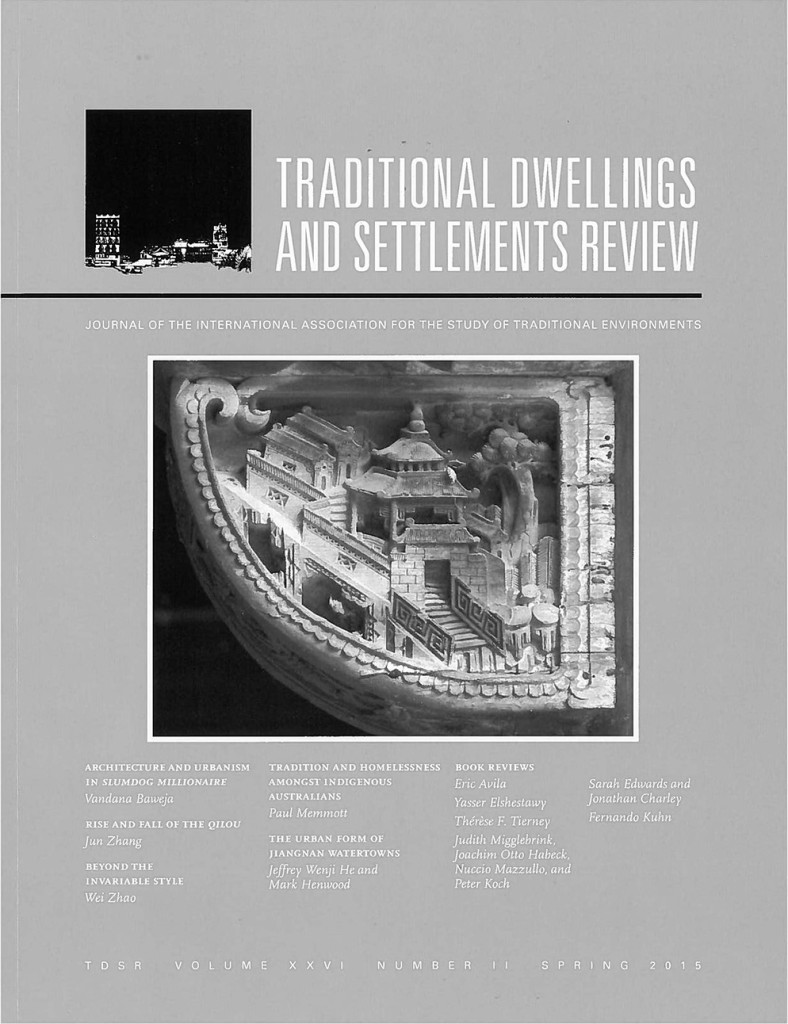
Contents
Editor’s Note
Architecture and Urbanism in Slumdog Millionaire: From Bombay to Mumbai
Vandana Baweja
Rise and Fall of the Qilou: Metamorphosis of Forms and Meanings in the Built Environment of Guangzhou
Jun Zhang
Beyond the Invariable Style: The Development of Residential Architecture in Yanxia Village, China
Wei Zhao
Differing Relations to Tradition Among Australian Indigenous Homeless People
Paul Memmott
Understanding the Urban Form of China’s Jiangnan Watertowns: Zhouzhang and Wuzhen
Jeffrey Wenji He and Mark Henwood
Fall 2014 Volume 26.1
Spring 2014 Volume 25.2
Fall 2013 Volume 25.1
Spring 2013 Volume 24.2
Fall 2012 Volume 24.1
Spring 2012 Volume 23.2
Fall 2011 Volume 23.1
Spring 2011 Volume 22.2
Fall 2010 Volume 22.1
Spring 2010 Volume 21.2
Fall 2009 Volume 21.1
Spring 2009 Volume 20.2
Fall 2008 Volume 20.1
Spring 2008 Volume 19.2
Fall 2007 Volume 19.1
Spring 2007 Volume 18.2
Fall 2006 Volume 18.1
Spring 2006 Volume 17.2
Fall 2005 Volume 17.1
Spring 2005 Volume 16.2
Fall 2004 Volume 16.1
Spring 2004 Volume 15.2
Fall 2003 Volume 15.1
Spring 2003 Volume 14.2
Fall 2002 Volume 14.1
Spring 2002 Volume 13.2
Fall 2001 Volume 13.1
Spring 2001 Volume 12.2
Fall 2000 Volume 12.1
Spring 2000 Volume 11.2
Fall 1999 Volume 11.1
Spring 1999 Volume 10.2
Fall 1998 Volume 10.1
Spring 1998 Volume 9.2
Fall 1997 Volume 9.1
Spring 1997 Volume 8.2
Fall 1996 Volume 8.1
Spring 1996 Volume 7.2
Fall 1995 Volume 7.1
Spring 1995 Volume 6.2
Fall 1994 Volume 6.1
Spring 1994 Volume 5.2
Fall 1993 Volume 5.1
Spring 1993 Volume 4.2
Fall 1992 Volume 4.1
Spring 1992 Volume 3.2
Fall 1991 Volume 3.1
Spring 1991 Volume 2.2
Fall 1990 Volume 2.1
Spring 1990 Volume1.2
Fall 1989 Volume 1.1
